- Spillovers from Western bank failures have persisted in Asian financial credit spreads
- From a liquidity point of view, we see Asian banks to be fundamentally stronger
- Systemwide banking liquidity are more ample in Asia compared to US and Europe
- Funding stability is also better in Asia, given institutional and market features
- Credit risks in Asia are also well-contained, with a broad decline in NPL ratios
Related insights_tr

Global spillovers into Asian bank credit linger
The recent spate of Western bank failures has cast a spotlight on banking risks and chilled sentiment in financial credit. Despite the promise of support to depositors by US policymakers, liquidity pressures on US regional banks have not fully abated. The Fed’s new Bank Term Funding Program (BTFP) facility has continued to see high demand, with usage growing to a record of USD87bn as of 17 May.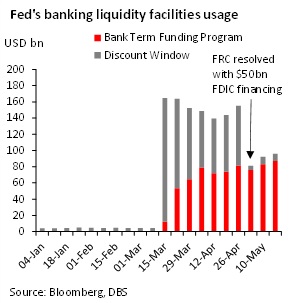
A regulatory write-down of Credit Suisse’s Additional Tier 1 (AT1) bonds, while preserving value for shareholders, has also upended creditor hierarchy understanding in financial credit. Given these developments, Asian bank credit has been adversely impacted, with investors still demanding significantly higher spreads (35-70bps) across subordinated credit, though these have partially narrowed from extremes in late March.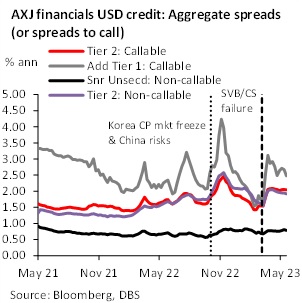
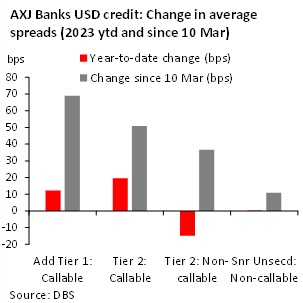
Assessing Asian banks’ liquidity risks
Are higher spreads in Asian financial credit warranted? With liquidity strains faced by Western banks being a key driver of financial credit risks, we examine the risks of similar liquidity stresses also occurring for Asian banks. We shall (i) discuss liquidity metrics for banks, (ii) analyse the impact of monetary policy on liquidity, as well as (iii) review institutional and market features that could influence liquidity risks in Asia.
LTD ratios indicate better Asian buffers
We focus on the LTD ratio as a traditional metric of liquidity risk—the risk that banks do not have sufficient liquid assets and must accept large discounts in their assets in exchange for cash on experiencing funding stresses. Comparing banks’ main illiquid asset (loans) against their most stable source of funds (deposits) indicates how vulnerable banks are to liquidity strains. The higher is the LTD ratio, the lesser is the liquidity buffer. During periods of deposit outflows, banks with high LTD ratio would need to quickly secure non-deposit funding which is usually more costly and less available subject to economic circumstance or realize losses in selling off their illiquid assets.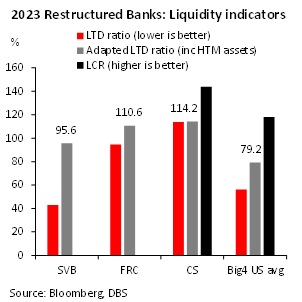
For US banks, we adapt the LTD ratio to include held-to-maturity (HTM) assets on top of loans. The failure of SVB shows that HTM securities matter for US banks, given their high holdings of these assets and large unrealized losses. All three recently restructured major banks (SVB, FRC, CS) show a very high adapted LDR ratio of 95% to 115%, compared to an average 79% for the Big 4 US banks. This clearly indicates their elevated vulnerability to liquidity strains.
While Basel III reforms have introduced the more sophisticated Liquidity Coverage Ratio (LCR) and Net Stable Funding Ratio (NFSR), LTD ratio are still relevant. First, not all banks will disclose LCR or NSFR, with larger banks typically the ones that do so. Second, assumptions underpinning the net outflows component of the LCR may not always hold, as evident from CS’s liquidity stresses despite a very high LCR of 144%. In contrast, the LTD ratio does not make assumptions about the rate of outflows and is more robust to extreme stress scenarios.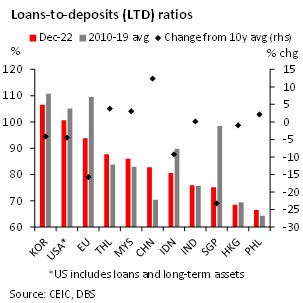
Given the sharp rise in US rates and US banks’ large holdings of long-duration MBS, we also include long-term assets (> 5Y maturity) into the US LTD ratio, as these assets will need to be funded to realizing losses. With our adapted LTD ratio being above 100%, US banks do appear to be vulnerable to liquidity risks. Similarly, European banks have a quite high LTD ratio of over 90%. For Asian banks, most have LTD ratios that are below 90%, except for Korean banks. This suggests that liquidity vulnerabilities are generally lesser in Asia compared to the West.
We note that Korean banks are a special case with high LTD ratios. This is because of their higher dependence on bank debentures sold to retail investors who want to earn higher rates. Korean debentures may thus be considered as a more stable source of funding, unlike typical debentures sold to institutions. In our view, this unique funding channel is likely more stable than wholesale funding, but do not offer the same degree of stability as bona fide deposits. We observe that the Korean debenture market was impacted negatively during the 2008 Global Financial Crisis. Korea’s LTD is also slated to fall this year, as the Financial Services Commission (FSC) had previously raised the LTD ratio cap to 105% given a credit crunch last year, before an eventual normalization to 100% in end June.
Besides being lower compared to the West, Asian LTD ratios have also generally been falling (or stayed stable) compared to their 10y average level from 2010 to 2019. This indicates that Asian banks have also not been aggressive in extending loans compared to historical norms. Only Chinese banks saw a significant 12% rise in their LTD ratio from the decade average, which largely reflects liberalization after China removed a 75% cap on the LTD ratio in 2015
Lesser risks from QT & monetary policy
Recent research by Acharya, Chauhan, Rajan, and Steffen (2022) suggest that banking vulnerabilities can perhaps be heightened by liquidity dependence. This means that bank deposits and credit tend to rise alongside an increase in reserve money under QE, but there is no mechanism for a symmetric decline in deposits when money supply falls under QT. As such, QT poses risks of systemic liquidity shocks to the banking sector as reserve money shrinks, while deposit claims stay unchanged.
Of course, such a view presupposes that there is no “excess” liquidity in the banking system. Concerns about system liquidity can also be partially mitigated by mechanisms to provide reserve money to banks, such as through the discount window or the Fed’s BTFP facility. Nevertheless, such reserve money facilities are costly compared to deposits, and there are thus economic constraints for banks to tap them. Excessively tight liquidity conditions thus remain a potential risk under QT. How should we assess these conditions? The growth of monetary aggregates, such as M2, can be a useful metric, with lower M2 growth associated with tighter liquidity. Interestingly, only the US has seen its M2 growth turned negative on a y/y basis, after the Fed began quantitative tightening in June 22. Furthermore, the US has also seen the sharpest fall in M2 growth relative to its 5y average growth from 2018-2022.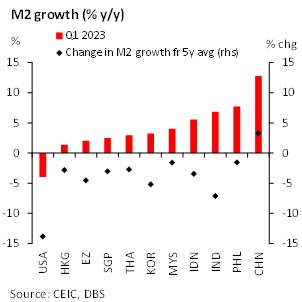
As it stands, Asian and European monetary policies are nowhere as tight as in the US, with M2 growth still positive across all countries. Asian central banks also do not have overhang from a large balance sheet that needs to be shrunk, unlike the ECB which is slated to accelerate the pace of its balance sheet reduction in July by ending APP reinvestment. Thus, from a monetary perspective, we expect Asian banks’ liquidity to be less fraught with challenges, unlike US and European banks. Hong Kong banks could face some risks given the USD/HKD peg and a diminished aggregate balance, but risks are well-mitigated due to Hong Kong banks’ lower LTD ratio.
Institutional and market features help funding
In our previous publication (see Asian banks: Better insulated from contagion risks, 24 Mar 23), we highlighted that deposit funding are more stable for Asian banks for three reasons:
- Vast majority of deposit accounts (>90%) are fully insured
- High confidence with many institutions being partially owned, or sponsored, by governments
- General orientation towards retail and corporate clientele with high deposit stability
Furthermore, Asian bond markets have less longer-tenor bonds compared to the US. Over 60% of the US Treasury and agency MBS market comprises of bonds with over 10 years of remaining maturity. The inverse is true for Asia, with under 40% of government bonds having more than 10y of remaining maturity. This implies that scope for Asian banks to face duration risk mismanagement is low, even if rates volatility is to pick up with Asian central banks being more hawkish than expected. We do not see risks of unrealized losses for portfolios held at amortized costs being a risk or triggering deposit flight for Asian banks.
Credit risks and NPL trends have improved
One fact in banking is that liquidity strains do not just happen by random chance but are usually catalysed by increased uncertainty over credit quality. Given the wide profile of credit risks across Asian banks, we choose to focus only on Chinese real estate risks given widespread Chinese developer defaults since late last year, and a possibly high impact to the rest of Asia. From a macro perspective Chinese banking risks from real estate are likely small.
First, China’s property outlook has unquestionably improved in 2023. Following China’s reopening at the end of 2022, residential property prices have now rebounded strongly, with broad-based increases across major cities. Mortgage boycotts that were prevalent in Aug-Sep have also dissipated after the authorities decreed loan funding to resume construction. As such, NPL risks for Chinese banks’ mortgages should be significantly reduced.
One remaining concern is developers’ liquidity, which is still problematic. Property sales have also softened somewhat after a surge post-reopening. Nevertheless, the rise in collateral values is still good news, with developer loans typically secured by land and property. Overall, Chinese banks’ NPL and special mention loan ratios have steadily declined back to pre-pandemic levels. Large banks’ NPL ratio has eased to 1.27%, while shareholding banks’ NPL ratio has also fallen to a record low of 1.31%.
Finally, we observe a trend of declining NPL ratios across Asia ex-Japan. Most economies NPL ratios have peaked in mid-2021, before declining amid reopening momentum. Only Indonesian and Philippine banks continue to show NPL ratios that are still higher than pre-pandemic 2019 levels. But even for them, the trend of gradual improvement of asset quality has largely continued.
Confidence-building with upcoming AT1 calls
Despite the resilient Asian banking outlook, market confidence has, to a degree, been affected by the write-down of CS AT1 by FINMA in March. This case has also made clear that national regulators’ approach towards AT1 bondholders are not all the same.
In Asia, MAS has affirmed that it intends to abide by the hierarchy of claims for liquidation during a bank resolution (or restructuring). Holders of Singaporean banks’ AT1 bonds are entitled to claim any difference between what they receive in a resolution, and what they would otherwise receive in a liquidation. Similarly, HKMA has clarified that capital holders should expect to be treated in resolution in accordance with the priority they would enjoy on a winding up of the institution. This implies that losses are to be first absorbed by equity holders, before AT1 and Tier 2 bond holders. However, no other Asian regulators, besides MAS and HKMA, had made a commitment to prioritize AT1 bondholders over equity holders in a restructuring.
Upholding creditor hierarchy in a resolution helps keeps the restructuring mechanism strategy-proof, with regulators’ inherent bias or private information being irrelevant in affecting the strategy of AT1 investors. The is because the outcome of AT1 bonds will obviously dominate the outcome for equity under all scenarios. If regulators have some discretion deciding how to allocate losses between equity and bondholders in a resolution, then the strategy of AT1 investors will become more difficult to analyse, as it is now subject to their expectations of what a regulator’s course of action could be. This could mean that AT1 investors will simply price the worst-case scenario of a permanent write-down (or equity conversion) when banks’ CET1 ratio falls below regulatory minimums, or when there is a viability-threatening liquidity event.
Tail risks are too small at this juncture for such worst-case considerations to matter. We expect Asian subordinated credit spreads to narrow further, as investor confidence returns eventually when a slew of AT1 calls materialize, starting in late July.
To read the full report, click here to Download the PDF.
Topic
GENERAL DISCLOSURE/ DISCLAIMER (For Macroeconomics, Currencies, Interest Rates)
The information herein is published by DBS Bank Ltd and/or DBS Bank (Hong Kong) Limited (each and/or collectively, the “Company”). This report is intended for “Accredited Investors” and “Institutional Investors” (defined under the Financial Advisers Act and Securities and Futures Act of Singapore, and their subsidiary legislation), as well as “Professional Investors” (defined under the Securities and Futures Ordinance of Hong Kong) only. It is based on information obtained from sources believed to be reliable, but the Company does not make any representation or warranty, express or implied, as to its accuracy, completeness, timeliness or correctness for any particular purpose. Opinions expressed are subject to change without notice. This research is prepared for general circulation. Any recommendation contained herein does not have regard to the specific investment objectives, financial situation and the particular needs of any specific addressee. The information herein is published for the information of addressees only and is not to be taken in substitution for the exercise of judgement by addressees, who should obtain separate legal or financial advice. The Company, or any of its related companies or any individuals connected with the group accepts no liability for any direct, special, indirect, consequential, incidental damages or any other loss or damages of any kind arising from any use of the information herein (including any error, omission or misstatement herein, negligent or otherwise) or further communication thereof, even if the Company or any other person has been advised of the possibility thereof. The information herein is not to be construed as an offer or a solicitation of an offer to buy or sell any securities, futures, options or other financial instruments or to provide any investment advice or services. The Company and its associates, their directors, officers and/or employees may have positions or other interests in, and may effect transactions in securities mentioned herein and may also perform or seek to perform broking, investment banking and other banking or financial services for these companies. The information herein is not directed to, or intended for distribution to or use by, any person or entity that is a citizen or resident of or located in any locality, state, country, or other jurisdiction (including but not limited to citizens or residents of the United States of America) where such distribution, publication, availability or use would be contrary to law or regulation. The information is not an offer to sell or the solicitation of an offer to buy any security in any jurisdiction (including but not limited to the United States of America) where such an offer or solicitation would be contrary to law or regulation.
This report is distributed in Singapore by DBS Bank Ltd (Company Regn. No. 196800306E) which is Exempt Financial Advisers as defined in the Financial Advisers Act and regulated by the Monetary Authority of Singapore. DBS Bank Ltd may distribute reports produced by its respective foreign entities, affiliates or other foreign research houses pursuant to an arrangement under Regulation 32C of the Financial Advisers Regulations. Singapore recipients should contact DBS Bank Ltd at 65-6878-8888 for matters arising from, or in connection with the report.
DBS Bank Ltd., 12 Marina Boulevard, Marina Bay Financial Centre Tower 3, Singapore 018982. Tel: 65-6878-8888. Company Registration No. 196800306E.
DBS Bank Ltd., Hong Kong Branch, a company incorporated in Singapore with limited liability. 18th Floor, The Center, 99 Queen’s Road Central, Central, Hong Kong SAR.
DBS Bank (Hong Kong) Limited, a company incorporated in Hong Kong with limited liability. 13th Floor One Island East, 18 Westlands Road, Quarry Bay, Hong Kong SAR
Virtual currencies are highly speculative digital "virtual commodities", and are not currencies. It is not a financial product approved by the Taiwan Financial Supervisory Commission, and the safeguards of the existing investor protection regime does not apply. The prices of virtual currencies may fluctuate greatly, and the investment risk is high. Before engaging in such transactions, the investor should carefully assess the risks, and seek its own independent advice.
GENERAL DISCLOSURE/DISCLAIMER (Credit)
Completed Date: 18 Jan 2023 11:04:34 (SGT)
Dissemination Date: 18 Jan 2023 11:04:34 (SGT)
Sources for all charts and tables are DBS Bank unless otherwise specified
GENERAL DISCLOSURE/DISCLAIMER
This report is prepared by DBS Bank Ltd. This report is solely intended for the clients of DBS Bank Ltd, DBS Vickers Securities (Singapore) Pte Ltd, its respective connected and associated corporations and affiliates only and no part of this document may be (i) copied, photocopied or duplicated in any form or by any means or (ii) redistributed without the prior written consent of DBS Bank Ltd.
The research set out in this report is based on information obtained from sources believed to be reliable, but we (which collectively refers to DBS Bank Ltd, DBS Vickers Securities (Singapore) Pte Ltd, its respective connected and associated corporations, affiliates and their respective directors, officers, employees and agents (collectively, the “DBS Group”) have not conducted due diligence on any of the companies, verified any information or sources or taken into account any other factors which we may consider to be relevant or appropriate in preparing the research. Accordingly, we do not make any representation or warranty as to the accuracy, completeness or correctness of the research set out in this report. Opinions expressed are subject to change without notice. This research is prepared for general circulation. Any recommendation contained in this document does not have regard to the specific investment objectives, financial situation and the particular needs of any specific addressee. This document is for the information of addressees only and is not to be taken in substitution for the exercise of judgement by addressees, who should obtain separate independent legal or financial advice. The DBS Group accepts no liability whatsoever for any direct, indirect and/or consequential loss (including any claims for loss of profit) arising from any use of and/or reliance upon this document and/or further communication given in relation to this document. This document is not to be construed as an offer or a solicitation of an offer to buy or sell any securities. The DBS Group, along with its affiliates and/or persons associated with any of them may from time to time have interests in the securities mentioned in this document. The DBS Group, may have positions in, and may effect transactions in securities mentioned herein and may also perform or seek to perform broking, investment banking and other banking services for these companies.
Any valuations, opinions, estimates, forecasts, ratings or risk assessments herein constitutes a judgment as of the date of this report, and there can be no assurance that future results or events will be consistent with any such valuations, opinions, estimates, forecasts, ratings or risk assessments. The information in this document is subject to change without notice, its accuracy is not guaranteed, it may be incomplete or condensed, it may not contain all material information concerning the company (or companies) referred to in this report and the DBS Group is under no obligation to update the information in this report.
This publication has not been reviewed or authorized by any regulatory authority in Singapore, Hong Kong or elsewhere. There is no planned schedule or frequency for updating research publication relating to any issuer.
The valuations, opinions, estimates, forecasts, ratings or risk assessments described in this report were based upon a number of estimates and assumptions and are inherently subject to significant uncertainties and contingencies. It can be expected that one or more of the estimates on which the valuations, opinions, estimates, forecasts, ratings or risk assessments were based will not materialize or will vary significantly from actual results. Therefore, the inclusion of the valuations, opinions, estimates, forecasts, ratings or risk assessments described herein IS NOT TO BE RELIED UPON as a representation and/or warranty by the DBS Group (and/or any persons associated with the aforesaid entities), that:
(a) such valuations, opinions, estimates, forecasts, ratings or risk assessments or their underlying assumptions will be achieved, and
(b) there is any assurance that future results or events will be consistent with any such valuations, opinions, estimates, forecasts, ratings or risk assessments stated therein.
Please contact the primary analyst for valuation methodologies and assumptions associated with the covered companies or price targets.
Any assumptions made in this report that refers to commodities, are for the purposes of making forecasts for the company (or companies) mentioned herein. They are not to be construed as recommendations to trade in the physical commodity or in the futures contract relating to the commodity referred to in this report.
ANALYST CERTIFICATION
The research analyst(s) primarily responsible for the content of this research report, in part or in whole, certifies that the views about the companies and their securities expressed in this report accurately reflect his/her personal views. The analyst(s) also certifies that no part of his/her compensation was, is, or will be, directly or indirectly, related to specific recommendations or views expressed in the report. The research analyst (s) primarily responsible for the content of this research report, in part or in whole, certifies that he or his associate[1] does not serve as an officer of the issuer or the new listing applicant (which includes in the case of a real estate investment trust, an officer of the management company of the real estate investment trust; and in the case of any other entity, an officer or its equivalent counterparty of the entity who is responsible for the management of the issuer or the new listing applicant) and the research analyst(s) primarily responsible for the content of this research report or his associate does not have financial interests[2] in relation to an issuer or a new listing applicant that the analyst reviews. DBS Group has procedures in place to eliminate, avoid and manage any potential conflicts of interests that may arise in connection with the production of research reports. The research analyst(s) responsible for this report operates as part of a separate and independent team to the investment banking function of the DBS Group and procedures are in place to ensure that confidential information held by either the research or investment banking function is handled appropriately. There is no direct link of DBS Group's compensation to any specific investment banking function of the DBS Group.
COMPANY-SPECIFIC / REGULATORY DISCLOSURES
- DBS Bank Ltd, DBS HK, DBS Vickers Securities (Singapore) Pte Ltd (''DBSVS'') or their subsidiaries and/or other affiliates do not have a proprietary position in the securities recommended in this report as of 30 Jun 2022.
Compensation for investment banking services:
- DBSVUSA does not have its own investment banking or research department, nor has it participated in any public offering of securities as a manager or co-manager or in any other investment banking transaction in the past twelve months. Any US persons wishing to obtain further information, including any clarification on disclosures in this disclaimer, or to effect a transaction in any security discussed in this document should contact DBSVUSA exclusively.
Disclosure of previous investment recommendation produced:
- DBS Bank Ltd, DBS Vickers Securities (Singapore) Pte Ltd (''DBSVS''), their subsidiaries and/or other affiliates may have published other investment recommendations in respect of the same securities / instruments recommended in this research report during the preceding 12 months. Please contact the primary analyst listed on page 1 of this report to view previous investment recommendations published by DBS Bank Ltd, DBS Vickers Securities (Singapore) Pte Ltd (''DBSVS''), their subsidiaries and/or other affiliates in the preceding 12 months.
RESTRICTIONS ON DISTRIBUTION
General | This report is not directed to, or intended for distribution to or use by, any person or entity who is a citizen or resident of or located in any locality, state, country or other jurisdiction where such distribution, publication, availability or use would be contrary to law or regulation. |
Australia | This report is being distributed in Australia by DBS Bank Ltd, DBS Vickers Securities (Singapore) Pte Ltd (“DBSVS”) or DBSV HK. DBS Bank Ltd holds Australian Financial Services Licence no. 475946. DBS Bank Ltd, DBSVS and DBSV HK are exempted from the requirement to hold an Australian Financial Services Licence under the Corporation Act 2001 (“CA”) in respect of financial services provided to the recipients. Both DBS and DBSVS are regulated by the Monetary Authority of Singapore under the laws of Singapore, and DBSV HK is regulated by the Hong Kong Securities and Futures Commission under the laws of Hong Kong, which differ from Australian laws. Distribution of this report is intended only for “wholesale investors” within the meaning of the CA. |
Hong Kong | This report has been prepared by a personnel of DBS Bank Ltd, who is not licensed by the Hong Kong Securities and Futures Commission to carry on the regulated activity of advising on securities in Hong Kong pursuant to the Securities and Futures Ordinance (Chapter 571 of the Laws of Hong Kong). This report is being distributed in Hong Kong and is attributable to DBS Bank (Hong Kong) Limited (''DBS HK''), a registered institution registered with the Hong Kong Securities and Futures Commission to carry on the regulated activity of advising on securities pursuant to the Securities and Futures Ordinance (Chapter 571 of the Laws of Hong Kong). DBS Bank Ltd., Hong Kong Branch is a limited liability company incorporated in Singapore. For any query regarding the materials herein, please contact Dennis Lam (Reg No. AH8290) at [email protected] |
Indonesia | This report is being distributed in Indonesia by PT DBS Vickers Sekuritas Indonesia. |
Malaysia | This report is distributed in Malaysia by AllianceDBS Research Sdn Bhd ("ADBSR"). Recipients of this report, received from ADBSR are to contact the undersigned at 603-2604 3333 in respect of any matters arising from or in connection with this report. In addition to the General Disclosure/Disclaimer found at the preceding page, recipients of this report are advised that ADBSR (the preparer of this report), its holding company Alliance Investment Bank Berhad, their respective connected and associated corporations, affiliates, their directors, officers, employees, agents and parties related or associated with any of them may have positions in, and may effect transactions in the securities mentioned herein and may also perform or seek to perform broking, investment banking/corporate advisory and other services for the subject companies. They may also have received compensation and/or seek to obtain compensation for broking, investment banking/corporate advisory and other services from the subject companies. Wong Ming Tek, Executive Director, ADBSR |
Singapore | This report is distributed in Singapore by DBS Bank Ltd (Company Regn. No. 196800306E) or DBSVS (Company Regn No. 198600294G), both of which are Exempt Financial Advisers as defined in the Financial Advisers Act and regulated by the Monetary Authority of Singapore. DBS Bank Ltd and/or DBSVS, may distribute reports produced by its respective foreign entities, affiliates or other foreign research houses pursuant to an arrangement under Regulation 32C of the Financial Advisers Regulations. Where the report is distributed in Singapore to a person who is not an Accredited Investor, Expert Investor or an Institutional Investor, DBS Bank Ltd accepts legal responsibility for the contents of the report to such persons only to the extent required by law. Singapore recipients should contact DBS Bank Ltd at 6878 8888 for matters arising from, or in connection with the report. |
Thailand | This report is being distributed in Thailand by DBS Vickers Securities (Thailand) Co Ltd. For any query regarding the materials herein, please contact Chanpen Sirithanarattanakul at [email protected] |
United Kingdom | This report is produced by DBS Bank Ltd which is regulated by the Monetary Authority of Singapore. This report is disseminated in the United Kingdom by DBS Bank Ltd, London Branch (“DBS UK”). DBS UK is authorised by the Prudential Regulation Authority and is subject to regulation by the Financial Conduct Authority and limited regulation by the Prudential Regulation Authority. Details about the extent of our regulation by the Prudential Regulation Authority are available from us on request. In respect of the United Kingdom, this report is solely intended for the clients of DBS UK, its respective connected and associated corporations and affiliates only and no part of this document may be (i) copied, photocopied or duplicated in any form or by any means or (ii) redistributed without the prior written consent of DBS UK, This communication is directed at persons having professional experience in matters relating to investments. Any investment activity following from this communication will only be engaged in with such persons. Persons who do not have professional experience in matters relating to investments should not rely on this communication. |
Dubai International Financial Centre | This communication is provided to you as a Professional Client or Market Counterparty as defined in the DFSA Rulebook Conduct of Business Module (the "COB Module"), and should not be relied upon or acted on by any person which does not meet the criteria to be classified as a Professional Client or Market Counterparty under the DFSA rules. This communication is from the branch of DBS Bank Ltd operating in the Dubai International Financial Centre (the "DIFC") under the trading name "DBS Bank Ltd. (DIFC Branch)" ("DBS DIFC"), registered with the DIFC Registrar of Companies under number 156 and having its registered office at units 608 - 610, 6th Floor, Gate Precinct Building 5, PO Box 506538, DIFC, Dubai, United Arab Emirates. DBS DIFC is regulated by the Dubai Financial Services Authority (the "DFSA") with a DFSA reference number F000164. For more information on DBS DIFC and its affiliates, please see http://www.dbs.com/ae/our--network/default.page. Where this communication contains a research report, this research report is prepared by the entity referred to therein, which may be DBS Bank Ltd or a third party, and is provided to you by DBS DIFC. The research report has not been reviewed or authorised by the DFSA. Such research report is distributed on the express understanding that, whilst the information contained within is believed to be reliable, the information has not been independently verified by DBS DIFC. Unless otherwise indicated, this communication does not constitute an "Offer of Securities to the Public" as defined under Article 12 of the Markets Law (DIFC Law No.1 of 2012) or an "Offer of a Unit of a Fund" as defined under Article 19(2) of the Collective Investment Law (DIFC Law No.2 of 2010). The DFSA has no responsibility for reviewing or verifying this communication or any associated documents in connection with this investment and it is not subject to any form of regulation or approval by the DFSA. Accordingly, the DFSA has not approved this communication or any other associated documents in connection with this investment nor taken any steps to verify the information set out in this communication or any associated documents, and has no responsibility for them. The DFSA has not assessed the suitability of any investments to which the communication relates and, in respect of any Islamic investments (or other investments identified to be Shari'a compliant), neither we nor the DFSA has determined whether they are Shari'a compliant in any way. Any investments which this communication relates to may be illiquid and/or subject to restrictions on their resale. Prospective purchasers should conduct their own due diligence on any investments. If you do not understand the contents of this document you should consult an authorised financial adviser. |
United States | This report was prepared by DBS Bank Ltd. DBSVUSA did not participate in its preparation. The research analyst(s) named on this report are not registered as research analysts with FINRA and are not associated persons of DBSVUSA. The research analyst(s) are not subject to FINRA Rule 2241 restrictions on analyst compensation, communications with a subject company, public appearances and trading securities held by a research analyst. This report is being distributed in the United States by DBSVUSA, which accepts responsibility for its contents. This report may only be distributed to Major U.S. Institutional Investors (as defined in SEC Rule 15a-6) and to such other institutional investors and qualified persons as DBSVUSA may authorize. Any U.S. person receiving this report who wishes to effect transactions in any securities referred to herein should contact DBSVUSA directly and not its affiliate. |
Other jurisdictions | In any other jurisdictions, except if otherwise restricted by laws or regulations, this report is intended only for qualified, professional, institutional or sophisticated investors as defined in the laws and regulations of such jurisdictions. |
DBS Regional Research Offices
HONG KONG DBS (Hong Kong) Ltd Contact: Dennis Lam 13th Floor One Island East, 18 Westlands Road, Quarry Bay, Hong Kong Tel: 852 3668 4181 Fax: 852 2521 1812 e-mail: [email protected] | SINGAPORE DBS Bank Ltd Contact: Paul Yong 12 Marina Boulevard, Marina Bay Financial Centre Tower 3 Singapore 018982 Tel: 65 6878 8888 e-mail: [email protected] Company Regn. No. 196800306E
|
INDONESIA PT DBS Vickers Sekuritas (Indonesia) Contact: Maynard Priajaya Arif DBS Bank Tower Ciputra World 1, 32/F Jl. Prof. Dr. Satrio Kav. 3-5 Jakarta 12940, Indonesia Tel: 62 21 3003 4900 Fax: 6221 3003 4943 e-mail: [email protected]
| THAILAND DBS Vickers Securities (Thailand) Co Ltd Contact: Chanpen Sirithanarattanakul 989 Siam Piwat Tower Building, 9th, 14th-15th Floor Rama 1 Road, Pathumwan, Bangkok Thailand 10330 Tel. 66 2 857 7831 Fax: 66 2 658 1269 e-mail: [email protected] Company Regn. No 0105539127012 Securities and Exchange Commission, Thailand |
[1] An associate is defined as (i) the spouse, or any minor child (natural or adopted) or minor step-child, of the analyst; (ii) the trustee of a trust of which the analyst, his spouse, minor child (natural or adopted) or minor step-child, is a beneficiary or discretionary object; or (iii) another person accustomed or obliged to act in accordance with the directions or instructions of the analyst.
[2] Financial interest is defined as interests that are commonly known financial interest, such as investment in the securities in respect of an issuer or a new listing applicant, or financial accommodation arrangement between the issuer or the new listing applicant and the firm or analysis. This term does not include commercial lending conducted at arm's length, or investments in any collective investment scheme other than an issuer or new listing applicant notwithstanding the fact that the scheme has investments in securities in respect of an issuer or a new listing applicant.



